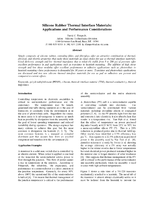Arlon Silicone Technologies - now part of Rogers Corporation
Silicone Rubber Thermal Interface Materials; Applications and Performance Considerations
Highlighting that attractive combination of thermal, physical, and electrical properties could make a material as an ideal choice to be used as a thermal interface material (TIM), this paper discusses the performance of a TIM in transistor and photovoltaic applications. It evaluates two TIMs from Arlon and a leading competitor consisting of silicone rubber, an extending filler system, and a fiberglass support fabric, by comparing their thermal impedance as a function of pressure, shear strength, shear modulus, and dielectric breakdown strength. Figures illustrating side view of a transistor/heatsink, and thermal impedance as a function of pressure for Arlon B and competitor B are included. Paper concludes that Arlon A and B TIM's offer excellent thermal, mechanical, and electrical properties, and lists low thermal impedance, high shear strength, and good electrical isolation as the benefits offered by them as both adhesives and pads.

Table of Contents
- Introduction
- Application Examples
- Materials
- Conclusion
- Figures
- Side View of a Transistor/heatsink
- Apparent Thermal Conductivity of Arlon A and B TIM
- Thermal Impedance as a Function of Pressure for Arlon A and Competitor A
- Arlon A Micrograph. Area is 0.008 in2
- Competitor A Micrograph. Area is 0.008 in2
- Thermal Impedance as a Function of Pressure for Arlon B and Competitor B
- Arlon B Micrograph. Area is 0.008 in2
- Competitor B Micrograph. Area is 0.008 in2
- Lap Shear Strength of Arlon A and B. Error Bars Represent 3 Standard Deviations
- Shear Modulus of Arlon A and B
- Dielectric Strength of 0.009" Thick Arlon A and B per ASTM D149

